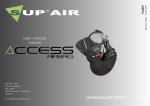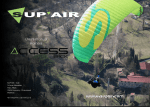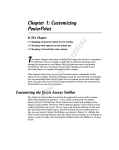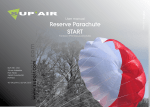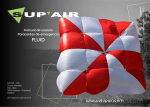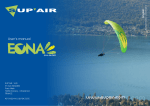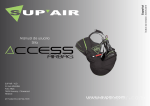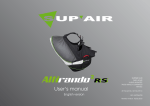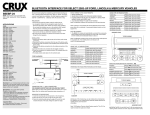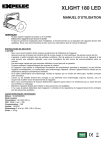Download User`s manual
Transcript
FLUID SUP’AIR - VLD 34 rue Adrastée Parc Altaïs 74650 Annecy - Chavanod FRANCE 45°54.024’N / 06°04.725’E Revision index: 03/11/2015 English User manual Reserve Parachute FLUID reserve parachute’s manual FLUID Thank you for choosing the FLUID reserve parachute!.We are glad to be able to share our common paragliding passion with you. SUP’AIR has been designing, manufacturing and distributing accessories world wide since 1982. Choosing a SUP’AIR product is the right choice for anyone to make, for it is supported by thirty year of expertise and innovating designs driven by customer feedback always taken into account. Next, are explicit instructions to familiarize yourself with the product’s technical features. Please, carefully read the following content! Visiting our website at www.supair.com , will also bring you the latest updates. Additionally, if in doubt, questions will be answered by contacting any of our network representatives. Naturally the entire SUP’AIR Team will be at your disposal to promptly respond to any additional question you may have by contacting it at [email protected] We wish you the best of flights. The SUP’AIR team. SUP’AIR _FLUID Page 2 FLUID reserve parachute’s manual FLUID Introduction Technical specifications Equipment overview EN 1249 Norm Use Reserve parachute/harness connection Packing Measurement table Maintenance Warranty Disclaimer Service Book List of contents 4 5 6 7 9 10 13 24 26 27 27 28 SUP’AIR _FLUID Page 3 FLUID reserve parachute’s manual FLUID Introduction Welcome to the world of free flying : a shared world of passion. The FLUID parachute meets all the requirements emphasizing safety while providing better performance than TRADITIONAL models: Faster opening, more stability, and a lower sink rate. The reserve parachute FLUID was designed by the SUP’AIR in-house research and development team. This model aims above all, to be a high-end quality product ensuring optimal safety. We use known materials for best results and highest performance. The design and material choices were well thought-out in regard to longevity and quality. SUP’AIR’s reserve parachute FLUID harness was certified EN 12491 and LTF 91/09 Indicating that it meets European and German safety requirements. After reading this manual, we recommend you to conduct a harness hang-test before your first flight to ensure proper rescue setup and functionality. N.B: Three important icons will help you when reading this manual Advice Caution ! Danger !! SUP’AIR _FLUID Page 4 FLUID reserve parachute’s manual FLUID Technical specifications FLUID Size M Size L Maximum Total Hooking Weight.* 100 Kg 125 kg Weight 1.66 Kg 1.87Kg Surface area 33.3 m2 38.8 m2 Volume (max) (cm3) 3 800 4 800 Opening time 2.5 sec 2.5 sec Cone length 4.5m 5m *Total flying weigth without the glider. SUP’AIR _FLUID Page 5 FLUID reserve parachute’s manual FLUID 1 Folded reserve parachute inside its deployment bag ( POD ).. 2 Single reserve parachute bridle loop. 3 Label with serial number, and manufacturing date. 4 Split risers 5 Maillons Rapides® 6mm 6 Flexible toric rings Equipment overview 1 3 2 5 4 6 SUP’AIR _FLUID Page 6 FLUID reserve parachute’s manual FLUID This notice shows the information requested by the EN 1291 norm. This European Norm (EN) is required for all the paragliding reserve parachutes. All our reserve parachutes are conforming to the EN norm. The reserve parachute certification code EN 12491 is described as follows: - Flight proper sequence: during a straight flight, the reserve parachute is deployed. In order to conduct accurately reproducible tests by avoiding any interference from the paraglider, the test-pilot releases his paraglider at peak height during a roll to begin the descent with an important instability factor. •The maximum sink rate is measured during the last 30 meters, the paragliding wing is released, below or equal to 5,5 m/s under maximum load. •Stability is checked in a subjective visual way ( with a rolling effect or not ), and is gauged against the overall sink rate ( an unstable reserve parachute usually demonstrates a higher sink rate). •The reserve parachute opening speed must be inferior to 5 seconds. - Structural tests ( resistance ): consists of verifying the overall structural integrity of the parachute under maximal load for a given horizontal 32 m/s speed. There can not be any failure / damage taking place on the riser / lines / canopy cascade during the entire procedure. EN 12491 norm Flight test European Norm 12491 Opening speed + Wing jettisoning STABILITY Sink rate < 5,5 m/s at maximum load. The certification results can be found at www.supair. com SUP’AIR _FLUID Page 7 FLUID reserve parachute’s manual FLUID EN 12491 norm Structural test European Norm 12491 Horizontal speed 32 m/s or 115 km/h at maximum load. SUP’AIR _FLUID Page 8 FLUID reserve parachute’s manual FLUID Guideline procedures to follow with our reserve parachutes:: To begin with, we must stress that using a reserve parachute should never be taken for granted or considered to be without risks to the pilot. A reserve parachute is only there to deploy in case of an emergency situation. The pilot’s weight must conform to the parachute manufacturer’s recommended load limitations to be fully operational. Any intent to use a reserve parachute below or above the manufacturer’s recommended weight limitations is dangerous and must totally be avoided. - Any reserve parachute riser connection to the harness must result with the pilot landing on his legs and standing. The parachute must be left unmodified to keep it aligned with the certification procedure it went through to assure for a proper deployment sequence to take place. - It is very important to learn how the parachute works, and only during a SIV course (Simulated Flight Incident ) or equivalent exercise. Deploying the Reserve Canopy: - Find the deployment handle. - Hold it firmly and pull it out of the outer container or harness. - Using the deployment handle, jettison the inner pod forcefully into open air and AWAY from the paraglider. The reserve parachute pod will automatically open upon reaching maximum line and riser length once under tension. RESERVE PARACHUTE OWNER’S MANUAL - Due to its square design, the canopy will easily and quickly inflate. - Once the reserve parachute is deployed, the pilot must disable the paraglider by symmetrically pulling as much as possible on the «B» risers to bring the rescue overhead to stabilize the descent. - Upon landing, the pilot must be ready to cushion the impact by flexing his legs and roll sideways; exercising what is called a PLF landing ( Parachute Landing Fall ). RECOMMENDATION AND CARE FOR THE PARACHUTE AFTER A WATER LANDING: In case of a water landing, the parachute must be dried, followed by line stretching and reconditioning, following the manufacturer’s guide lines. Let the parachute dry outdoors in a shaded area, away from direct sunlight Pre-stretch the lines with a 30 kg., and 50 kg. load for the Apex in order to limit Nylon shrinkage due to moisture and humidity. It is preferable to check the lines length with a 10 kg. load (see measurements chart on page 13). - Proceed with the repacking procedure according to the manufacturer’s guide line manual. - Ensure a correct reserve parachute installation inside the harness by doing an extraction during a hang-test. Repeat installation procedure afterward. To be noted: An EN12491 certified reserve parachute must theoretically have a touch-down speed, equal or inferior to 5,5 m/s, which corresponds to a 1,80 meter jump. This impacting speed can greatly vary due to a few relevant factors: The air mass, the overall hooking weight, the paragliding wing configuration / design, and the density altitude. Two recent flight incidents with use of similar reserve parachute models ( XLight ) during similar circumstances, demonstrated significant different results: - One pilot touched-down with a 5,2 m/s sink rate with his paraglider disabled. - The second pilot touched-down with a 9 m/s sink rate without a neutralized paragliding wing, or a free-fall jump from a 4 meter elevation The paragliding wing’s influence on the overall setup ( paraglider / reserve parachute ) is important and not predictable nor quantifiable. The scenario can not be reproduced during the tests. In spite of the positive statistics showing the obvious benefits of using a reserve parachute in case of an emergency, the later can not be taken for granted at any time or place. SUP’AIR _FLUID Page 9 FLUID reserve parachute’s manual FLUID Connecting the reserve parachute to the harness. The reserve parachute installation will vary relative to the riser type used. Please review the following recommendations : - « Y » risers setup ( Ref.:ELESOLOY ). >> Two (2) 6mm Maillons Rapides® are needed ( Ref. : MAILCARIN6 ) + two (2) toric elastic rings ( Ref. : MPPP044 ). - Separate STD risers ( Ref. : ELESOLOSTD ). >> One (1) square 7mm Maillon Rapide® will be needed ( Ref. : MAILCARIN7 ) + four (4) flexible toric rings ( Ref. : MPPP044 ). Follow the instructions corresponding to the type of risers you intend to use. 1. Reserve parachute to harness connection with « Y » risers. >> « Y » riser reserve parachute connection. Make a loop to loop ( Lark’s head ) knot between the single reserve parachute riser and the base of the « Y » riser where the bigger bridle diameter loop is located. >> « Y » riser connection to the harness. 1. - Take two (2) square 6mm Maillons Rapides® and two (2) flexible toric rings. - Unfasten the Velcros (or zip) located alongside the shoulder protective sleeves to reach the reserve parachute connection loops on the shoulder straps. 3. - Push the riser’s loop 4. - Give a second twist to the 5. - Tidy up the assembly. 2. - Open the Maillon Rapide® through the flexible toric ring. toric ring. - Be certain that the risers end loops - Push the bridle’s buckle through. - Push the maillon through the - Push the Maillon Rapide® are securely in place. - Push the maillon through the flexriser’s loop. through the riser loop. - Close the maillon tightly by hand. ible toric ring. - Complete tightening with pliers by - Twist making a ¼ tightening turn. 6. Repeat sequence 1 through 5 on the other side of the harness. 7. Tuck away the risers excess ( without making knots ) under one single flap : - Either to the right side if you wish to place your reserve parachute handle to the right ( recommended if right handed ). - Or to the left side if you wish to place your reserve parachute handle to the left ( recommended if left handed ). - Close the protective sleeves Velcros (or zip). SUP’AIR _FLUID Page 10 FLUID reserve parachute’s manual FLUID Connecting the reserve parachute to the harness. 2. Reserve parachute/harness connection with SDT separate risers. >> Risers to harness connection using a loop to loop ( Lark’s head ) knot.) 1. - Unfasten the 2. - Attach each riser to the shoulder attachment points by 3. - Assemble everything correctly. Velcros located making a Lark’s knot ( loop to loop connection ). Use the larg- Make sure for the risers not to be longer than one another. alongside the est bridle loop ends. - Tighten each connection securely. shoulder protective sleeves to reach the reserve parachute shoulder straps connection loops. >> Separate riser reserve parachute connection. One (1) square 7mm Maillon Rapide® will be needed + two (2) flexible toric rings. 1. - Open the 7mm 4. - Repeat steps 1 through 2. - Push the end riser 3. - Give a second square Maillon Rapide®. through the toric ring. 3 with the second riser. twist to the toric ring. - Connect the reserve - Push the maillon - Push the buckle parachute single riser through the risers through the maillon. loop. buckles. - Push the maillon through the toric ring - Twist 5. - Tidy up the assembly. - Be certain for the riser end loops to be securely fastened. - Close the Maillon Rapide® tightly by hand. - Tighten using pliers and making a ¼ turn. SUP’AIR _FLUID Page 11 FLUID reserve parachute’s manual FLUID Connecting the reserve parachute to the harness. 3. Installing the parachute in its container. Weather you have an outer front container or an integrated reserve parachute pocket in your harness, proceed with the installation according to the manufacturer’s guidelines. Check the completed installation during a hang-test. Have the installation checked by a professional outfit. Conduct an extraction test every six ( 6 ) months to ensure proper system functionality. Note : conducting a hang-test extraction does not imply deploying the reserve parachute which will stay inside its POD. Advise : In order to guaranty a quick opening speed and a sound structural integrity, your reserve parachute must be repacked every six months. Take advantage of the repacking procedure to conduct a hang-test extraction. Reserve parachute folding and installation inside the harness must conform to the specific guidelines found in this manual. SUP’AIR _FLUID Page 12 FLUID reserve parachute’s manual FLUID Packing Packing a reserve parachute is not very difficult but requires a methodical and precise folding procedure. If you feel uneasy about repacking the reserve parachute yourself, it will be advisable for you to seek professional assistance to do the job correctly. Tip: take advantage of having to repack your parachute, to deploy it on the ground and vent it for a while, prior proceeding to folding it again. Before each repacking procedure, the following sequence must be observed: - Carefully check each line from the canopy to the riser for any possible damage. - Aerate the parachute for at least twelve ( 12 ) hours. Not in direct sunlight nor in a room filled with polluting chemical agents ( sprays ). - Check the fabric for damage or soiling of any kind. - Inspect the pod and parachute pocket for wear and tear to ensure a clean extraction using a properly fastened reserve parachute handle to the pod. - Inspect the elasticated loop keeping the pod flaps securely closed. - If you notice something unusual, send your parachute to be inspected by a professional specialized certified outfit. 1. Folding preparation a. Make a selective list of the following items needed to complete the repacking procedure: • • • • • • • - The unfolded parachute - A small thin piece of line about 30cm long. - A fixed point and the necessary means to coonect the single reserve parachute riser. - Sand ballast, weights or books. - Elastics to keep the lines in place. - A pen. - the POD. b. Attach the parachute on a fixed point to keep it stretched and under tention. SUP’AIR _FLUID Page 13 FLUID reserve parachute’s manual FLUID Packing 1. Folding preparation (continued). C. Keep the parachute unruffled Check for the lines to run freely from the bridle «loop to loop» connection to the canopy’s leading edge. Divide the parachute in two sections (8 lines on each side), the Apex line must be placed in the middle. Layout the parachute on theground. 8 suspension lines Apex 8 suspension lines d. Take the first panel and lay it out flat on the floor.. Marker = tag Marker = tag SUP’AIR _FLUID Page 14 FLUID reserve parachute’s manual FLUID Assembling the lanyards Take the cord and push it through the lanyard of the first panel. b. Follow the leading edge to the next line, then the panel’s seam to find the second lanyard. c. Proceed in the same way until you have assembled all sixteen (16) layniards. d. Slightly tension the parachute on its longitudinal axis. Packing The lanyard is a small white strap ending with a loop. Then, firmly hold the cord keeping the lanyards tightly assembled together. SUP’AIR _FLUID Page 15 FLUID reserve parachute’s manual FLUID Packing 3. Folding the panels. Do not forget to firmly hold the cord keeping the lanyards together so that they remain assembled during the folding procedure. a. Extract and flatten the first panel ( tag ). This panel is a corner panel, it is red and is laid out flat in two stages: in a W-shape. 1 2 Aligning the leading edge. Flattening using the fold mark. Fold mark. W-shape. Excess fabric storage. b. Follow the leading edge to find the second panel. This panel is laid out flat in one motion, and rectangular shape. Rectangular shape. c. Follow the leading edge to find the third panel. This panel is white and rectangular shaped. It should be laid out flat in one motion. Excess fabric storage. SUP’AIR _FLUID Page 16 FLUID reserve parachute’s manual FLUID Packing 3. Laying out the panels (continued). d. Follow the leading edge to find the fourth panel. This panel is white and is laid out flat in two motions: in a W-shape using the fold mark. 1 2 Alignment of the leading edge. Laying out the panels using the fold mark. Fold mark. When folding the corner panels, pay attention to the excess fabric which must be tucked away flat inside the panel. Excess fabric storage. >> Once the first side is folded, continue by repeating steps «a» to «d» in order to fold the other three sides in the same manner. After flattening all the panels, the result should look as what is seen on the photo: SUP’AIR _FLUID Page 17 FLUID reserve parachute’s manual FLUID Packing Dividing the parachute in two sections. Do not forget to firmly hold the cord keeping the lanyards assembled together during the folding procedure. Follow this step to layout the parachute flat and symmetrically. By reversing the previous folding motions, re-open the parachute in two halves and symmetrically on the floor. Return a white panel W-shape (1), a white rectangular panel (2), a red rectangular panel (3), and a red panel W-shape (4), all twice. Stop at the second W-shaped panel ( 5 ). 2 4 3 1 5 5 Middle= is divided with the same number of panels on each side. SUP’AIR _FLUID Page 18 FLUID reserve parachute’s manual FLUID Packing 5. Folding the parachute. Do not forget to firmly hold the cord keeping the lanyards assembled together during the folding procedure. Fold each side of the parachute in a snail shell-like shape (2 folds), then fold one half over the other to make one long layer with the width of the POD. Use clips or sandbags to keep the folds in place during the folding procedure. 6 1 3 5 4 2 1 2 6 SUP’AIR _FLUID Page 19 FLUID reserve parachute’s manual FLUID Packing 5. Folding the parachute (continued). Do not forget to firmly hold the cord keeping the lanyards assembled together during the folding procedure. b. Coiling the canopy. Width reference. IMMEDIATELY REMOVE THE CORD HOLDING THE LANYARDS TOGETHER ! SUP’AIR _FLUID Page 20 FLUID reserve parachute’s manual FLUID Packing 6. Installing the reserve parachute inside its POD. a. Place the POD atop the parachute, then flip it all upside down while leaving a small space in front of the leading edge for subsequent line coiling. 2 1 Position the POD’s elastic loop opposed to the suspension lines. Do not pull the lines, they must not be under tension and best left slightly slackened atop the canopy. Close the rear flap and two side flaps. 2 1 3 SUP’AIR _FLUID Page 21 FLUID reserve parachute’s manual FLUID 6. Placing the parachute in its POD (continued). Packing c. Coil the lines into the space in front of the canopy while keeping 1.20 m of lines for the outer coiling. 1.20 m Installation marker. >> The suspension line loops must have a two fingers width. Tuck away the coiled lines inside the space in front of the canopy while keeping a 1.20m line length for the subsequent outer coiling. 1.20 m SUP’AIR _FLUID Page 22 FLUID reserve parachute’s manual FLUID Packing 7, Closing the POD. a.Close the fourth flap and push a 5cm ( 3 fingers ) line loops through the POD elastic loop to secure the flaps in place. Loop width = 3 fingers. ≈ 1 m loose lines. The folding procedure is completed. Make sure that all the equipment needed for the packing procedure is accounted for, and that none of it was mistakenly left inside the folded parachute. A video about the use and folding of the parachute is available on our website. SUP’AIR _FLUID Page 23 FLUID reserve parachute’s manual FLUID Measurement table FLUID Size M reserve parachute line chart. * Measurements made under a 5 kg. tension. Line Cut Sewn Line number B1 4840 4530 4 B2 4965 4655 8 B3 T1 T2 5315 2420 2910 5005 2110 2600 4 1 4 Apex 3300 2800 1 Line material Cousin 2411 rescue line 2 times 155 mm extra lenght ( 35 mm loop + 120 mm splice - stitching lenght = 90 mm) Liros 000991629 2 times 250 mm extra lenght ( 50 mm loop + 200 mm splice - stitching lenght = 150 mm) seam 90 mm splice 120 mm loop 35 mm seam 150 mm splice 200 mm loop 50 mm SUP’AIR _FLUID Page 24 FLUID reserve parachute’s manual FLUID Measurement table FLUID Size L reserve parachute line chart . * Measurements made under a 5 kg. tension. Line Cut Sewn Line number B1 5295 4985 4 B2 5435 5125 8 Cousin 2411 rescue line B3 T1 T2 5820 2630 3170 5510 2320 2860 4 1 4 Liros 000991628 Apex 3580 3080 1 Line material Edelrid A-6798-600001 2 times 155 mm extra lenght ( 35 mm loop + 120 mm splice - stitching lenght = 90 mm) 2 times 250 mm extra lenght ( 50 mm loop + 200 mm splice - stitching lenght = 150 mm) seam 90 mm splice 120 mm seam 150 mm splice 200 mm loop 35 mm loop 50 mm SUP’AIR _FLUID Page 25 FLUID reserve parachute’s manual FLUID MAINTENANCE MAINTENANCE 5 If wet, you will have to immediately dry your parachute to avoid any bacteria / fungi buildup. Gasoline contact, or any other solvent / chemical agent, can considerably decrease and compromise your reserve parachute’s structural integrity. If the case, the parachute will have to be controlled and checked by a professional specialized outfit. The outer container ( pod or also called diaper ), can be washed independently from the parachute, with water and mild unscented soap, rinsed and dried. As for the parachute itself and its lines, use water only. Storage and transport. When not in use, you must stow away your reserve parachute in a dry, cool, clean and UV rays free environment. During transport protect the harness against against abrasion or UV deterioration (use a bag). Avoid long transports in wet conditions. REPACKING FREQUENCY To guaranty a fast deployment sequence and proper care for your reserve parachute, you must open and repack it every six (6) months. LONGEVITY Your reserve parachute was designed to last ten years if properly maintained as per manufacturer’s recommendations. Pass that period, we will recommend you to have your parachute inspected at a professional certified outfit. The procedure should be implemented regularly through out that ten year period. RECYCLING Our materials have been specifically selected for their exceptional resilience and environmentally friendly abilities. None of the components used in the manufacturing of our reserve parachutes is environmentally harmful. The majority of the components used can be recycled.. We will ask you not to dispose of your old parachute with the regular trash but approach a specialized recycling facility instead. You can also bring it back to your SUP’AIR dealer who will send it back to us. Repairs In spite of using the highest quality products used during manufacturing, it is possible for your reserve to deteriorate through general use. If showing any sign of wear and tear, it should be sent for inspection and/or repairs at a professional certified facility. Hardware & Parts - POD Materials >> Line Cousins 2441 rescue line Liros 00099 - 1629 Edelrid >> Fabrics Dominico D20 SUP’AIR _FLUID Page 26 FLUID reserve parachute’s manual FLUID Warranty SUP’AIR takes great care in its product design and manufacturing. SUP’AIR guaranties its parachutes two years from the date of purchase against any defect or design flaw that would arise under normal use. Product mishandling, excessive exposure to aggressive factors (such as over heating, intense sunlight (UV), high humidity, aggressive chemical agents and such) that would become harmful and damaging to the merchandise, would void the warranty. Disclaimer Paragliding is an activity requiring specific skills and sound judgement. Learn how to fly within the environment of a certified paragliding school. Carry an insurance policy with you in addition to you pilot certification. Always mind and gauge your personal skills against the weather conditions of the day. Better be safe than sorry ! SUP’AIR can not be held responsible for your paragliding decisions or activities. This SUP’AIR product has been designed exclusively for paragliding. Any other activity such as skydiving or BASE jumping is absolutely forbidden. Pilot’s gear. It is essential for you to wear a suitable head protection (certified paragliding helmet), adequate footwear and right clothing for the activity. Moreover, carrying a reserve parachute connected to your harness in flight is highly recommend. SUP’AIR _FLUID Page 27 FLUID reserve parachute’s manual FLUID Service Book. This page will help you keep record of your FLUID scheduled maintenance. Purchase date Owner’s name Name and stamp of the shop Care Resale Purchase date Workshop’s name/ Buyer’s name Care Resale Purchase date Workshop’s name/ Buyer’s name Care Resale Purchase date Workshop’s name/ Buyer’s name Care Resale Purchase date Workshop’s name/ Buyer’s name SUP’AIR _FLUID Page 28 SUPAIR-VLD Parc Altaïs 34 rue Adrastée 74650 Chavanod, Annecy FRANCE [email protected] +33(0)4 50 45 75 29 45°54.024’N / 06°04.725’E





























